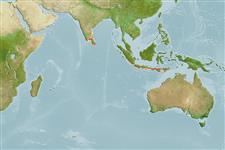>
Anguilliformes (Eels and morays) >
Muraenidae (Moray eels) > Muraeninae
Etymology: pelonates: Name from Greek 'pelos' for mud and 'nates' for dweller, refers to its mud-dwelling habit; noun in apposition.
More on authors: McCosker & Randall.
Environment: milieu / climate zone / depth range / distribution range
Ecologie
marien demersaal; diepte 15 - 32 m (Ref. 75775). Tropical
Western Pacific: Indonesia.
Grootte / Gewicht / Leeftijd
Maturity: Lm ? range ? - ? cm
Max length : 46.5 cm TL mannelijk / geslacht onbekend; (Ref. 75775)
Korte beschrijving
Morfologie | Morfometrie
Wervels: 155. This species is small, elongate, slender, brown moray has white spots and vermiculations on the head behind the rictus and extends into the anterior trunk; pale margins posteriorly on fins; anus before midbody; length of preanal 2.5-2.6 in TL; gill opening depth 33-35 in TL; head 10-11 in TL; short snout, rear margin of orbit above middle or eye; jaws moderately long, not recurved; conical teeth, some needle-like; biserial maxillary teeth, those on outer row smaller and closely spaced; mostly uniserial mandibular teeth, outer row smaller and closely spaced; MVF 6/56/154 (Ref,. 75775).
Found on mud bottom with scattered rocks in 15-32 m (Ref. 90102).
Levenscyclus en paargedrag
Maturiteit | Voortplanting | Paaien | Eieren | Fecunditeit | Larven
McCosker, J.E. and J.E. Randall, 2007. A new genus and species of mud-dwelling moray eel (Anguilliformes: Muraenidae) from Indonesia. Proc. Calif. Acad. Sci. 58(22):469-476. (Ref. 75775)
Status op de Rode Lijst van het IUCN (Ref. 130435)
Gevaar voor de mens
Harmless
Gebruik door de mens
Meer informatie
Lokale namenSynoniemenMetabolismePredatorenEcotoxicologieVoortplantingMaturiteitPaaienPaaiaggregatiesFecunditeitEierenOntwikkeling van de eieren
Leeftijd/GrootteGroeiLengte-gewichtLengte-lengteLengtefrequentiesMorfometrieMorfologieLarvenLarvale populatiedynamiekRekruteringAbundantieBRUVS
ReferentiesAquacultuurAquacultuurprofielKweeklijnenGeneticaElectrophoresesErfelijkheidZiektesVerwerkingNutrientsMassaconversie
Tools
Speciale rapporten
Download XML
Internetbronnen
Estimates based on models
Fylogenetische diversiteitsindex (Ref.
82804): PD
50 = 1.0000 [Uniqueness, from 0.5 = low to 2.0 = high].
Bayesian length-weight: a=0.00050 (0.00025 - 0.00101), b=3.26 (3.10 - 3.42), in cm total length, based on LWR estimates for this (Sub)family-body shape (Ref.
93245).
Trofisch niveau (Ref.
69278): 3.9 ±0.6 se; based on size and trophs of closest relatives
Weerstandsvermogen (Ref.
120179): Gemiddeld, minimale populatieverdubbelingstijd 1,4-4,4 jaar (Preliminary K or Fecundity.).
Fishing Vulnerability (Ref.
59153): Moderate vulnerability (37 of 100).
